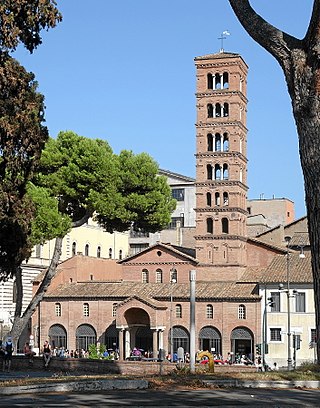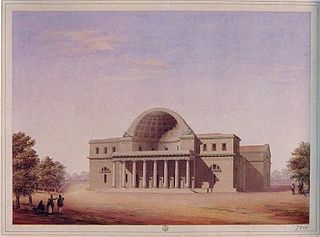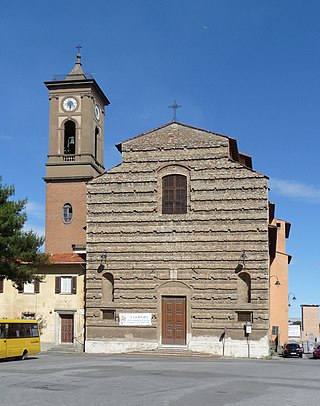
Livorno is a port city on the Ligurian Sea on the western coast of the Tuscany region, Italy. It is the capital of the Province of Livorno, having a population of 158,493 residents in December 2017. It is traditionally known in English as Leghorn.

The Basilica of Saint Mary in Cosmedin is a minor basilican church in Rome, Italy, dedicated to the Virgin Mary. It is located in the rione (neighborhood) of Ripa. Constructed first in the sixth century as a diaconia (deaconry) in an area of the city populated by Greek immigrants, it celebrated Eastern rites and currently serves the Melkite Greek Catholic community of Rome. The church was expanded in the eighth century and renovated in the twelfth century, when a campanile was added. A Baroque facade and interior refurbishment of 1718 were removed in 1894-99; the exterior was restored to twelfth-century form, while the architecture of the interior recalls the eighth century with twelfth-century furnishings. The narthex of the church contains the famous Bocca della Verità sculpture.

Monreale Cathedral is a Catholic church in Monreale, Metropolitan City of Palermo, Sicily, southern Italy. One of the greatest existent examples of Norman architecture, it was begun in 1174 by William II of Sicily. In 1182 the church, dedicated to the Nativity of the Virgin Mary, was, by a bull of Pope Lucius III, elevated to the rank of a metropolitan cathedral as the seat of the diocese of Monreale, which was elevated to the Archdiocese of Monreale in 1183. Since 2015 it has been part of the Arab-Norman Palermo and the Cathedral Churches of Cefalù and Monreale UNESCO World Heritage Site.

The Madonna dell'Orto is a church in Venice, Italy, in the sestiere of Cannaregio. This was the home parish of Tintoretto and holds a number of his works as well as his tomb.

The Cisternoni of Livorno are a series of three large buildings in the neoclassical style at Livorno, in Tuscany, Italy. They were constructed between 1829 and 1848 as part of a complex of purification plants and storage tanks to the Leopoldino aqueduct; a fourth cisternone planned at Castellaccia was never built. The cisternoni, literally "great cisterns", provided Livorno — a city that is still today one of the principal ports of the Mediterranean — with fresh and, more importantly, clean water throughout the 19th and 20th centuries.

Santo Stefano de Pinea or more commonly Santo Stefano del Cacco is a church in Rome dedicated to Saint Stephen, located at Via di Santo Stefano del Cacco 26.

The Shrine of Our Lady of Grace, also known as Sanctuary of Montenero, is a religious complex on the Monte Nero Livorno Hills, in Livorno, central Italy reachable by a funicular.

The Old English Cemetery is a cemetery in Livorno (Leghorn), central Italy, located on a plot of land near the Via Verdi, close to the Waldensian Church and to the formerly Anglican church of St. George. It is the oldest Protestant cemetery in Italy.

Santa Maria delle Grazie alle Fornaci fuori Porta Cavalleggeri is a Baroque style, Roman Catholic parish and titular church located at Piazza di Santa Maria alle Fornaci, south of Vatican City and north of the San Pietro train station in the Aurelio quarter. It was made a cardinalate deaconry by Pope John Paul II on 25 May 1985, and assigned it to Cardinal Duraisamy Simon Lourdusamy, then Prefect of the Congregation for the Oriental Churches. The church became vacant on 2 June 2014 after the death of Cardinal Lourdusamy. On November 11, 2016 it was announced that Mario Zenari will succeed him.

The church of Santi Severino e Sossio and the annexed monastery are located on via Bartolommeo Capasso in Naples, Italy.

San Sisto is a Romanesque-style Roman Catholic church in the town of Viterbo in the Region of Lazio. The church was once known as San Sisto fuori la Porta Romana.

San Donnino or San Donnino Martire is a Romanesque style Catholic church located at the intersection of Largo Cesare Battisti and Vicolo San Donnino in the historic center of Piacenza, Region of Emilia Romagna, Italy. Little is known of San Donnino, to whom the church is dedicated, as are other churches elsewhere, including Pisa. A St Domninus appears in early Church sources and some identify him with St Domninus of Fidenza, to whom Fidenza Cathedral is also dedicated. For some the Piacenza Domninus was a deacon of Piacenza in the early Christian period.

Santa Caterina da Siena is a Baroque architecture, Roman Catholic church in the district Venezia Nuova central Livorno, region of Tuscany, Italy. It stands in front of the Piazza dei Domenicani. The church is notable for its tall octagonal dome and lantern rising above a rough, unfinished rectangular base.

San Ferdinando is a Baroque style, Roman Catholic church located in Venezia Nuova district next to Piazza del Luogo Pio in Livorno, region of Tuscany, Italy. It is also called San Ferdinando Re or the Church of the Crocetta. Nearby is the deconsecrated church of Sant'Anna.
Giovanni del Fantasia (1670–1743) was an Italian architect and engineer, operating in a Baroque style, mainly in and around Livorno, region of Tuscany, Italy.

The Church of Santa Maria Maggiore is an important place of worship in the city of Trento, and the site of the Third Session of the Council of Trent. It was built by Antonio Medaglia on the model of the basilica of Sant'Andrea in Mantua, at the wish of the Prince-Archbishop Bernardo Clesio. In November 1973 Pope Paul VI accorded it the status of minor cathedral.
The following is a timeline of the history of the city of Livorno in the Tuscany region of Italy.

San Leone, once called the oratory or church of Santo Spirito, is a small Baroque-style Roman Catholic church located adjacent to the Vivarelli Colonna in Pistoia, region of Tuscany, Italy. In 2017, restoration of the Baroque era frescoes in the apse and ceilings were completed.

The Baths of the Rotonda are the remains of one of several Roman public baths in the city of Catania, Sicily. Built between the 1st and 2nd century CE, they are not far from the Roman theatre and the odeon. In the Byzantine era, the church of Santa Maria della Rotonda with its characteristic dome was built upon the remains of the Roman baths. Its walls are still covered in medieval and baroque frescoes.
























